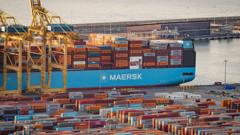In a significant breakthrough, US and EU negotiators have announced a trade agreement that could reshape economic ties, coming just ahead of critical discussions between the US and China. The high-stakes deal emerged after multiple intense discussions, culminating in personal involvement from both President Trump and European Commission President Ursula von der Leyen.
The agreement is vital for businesses on both sides, as the world's largest bilateral trade relationship relies heavily on mutual cooperation. President Trump and von der Leyen each herald this outcome as a victory; Trump touts it as one of the biggest deals to date, while the EU sidesteps the threat of escalating tariffs that could have reached 30%, ultimately settling at a 15% rate.
The financial implications are significant, with the US expected to gain around $90 billion from tariffs based on last year’s figures, and a projected $600 billion in new investments flowing into the nation. However, key details regarding the timeline and the specific sectors for these investments remain murky, raising questions about the deal's long-term impact.
While both parties engaged in tough negotiations, neither was willing to let talks extend past the August 1 deadline, emphasizing the urgency felt by both sides. The US's trade deficit with the EU, exceeding $236 billion, has long been a source of contention, with Trump labeling the situation as a drain on American wealth.
Von der Leyen acknowledges the need for strategic balance, asserting that rebalancing trade relations can enhance the mutual benefits of the partnership. The agreement also signals a vigorous approach to trade negotiations by the Trump administration, which has navigated challenging discussions with various nations, including recent deals with Japan and impending negotiations with Canada, Mexico, and China.
With renewed momentum, US negotiators are equipped for upcoming discussions with Beijing, where a potential pause on tariff increases could benefit global trade. However, as China has demonstrated a less flexible stance compared to other partners, the future of global trading dynamics remains delicate and unpredictable.
This latest US-EU agreement not only signifies progress in trade relations but also highlights the ongoing complexities of international commerce as political landscapes shift and evolve.





















